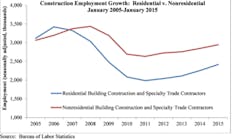Latest from Contractor Marketplace
Sponsored
The U.S. construction industry added 39,000 jobs in January, including 12,700 net new nonresidential jobs, according to the Bureau of Labor Statistics (BLS) preliminary estimate released Feb. 6.
December's estimate was revised downward from 48,000 to 44,000 net new jobs. With revisions, nonresidential construction expanded by 21,200 jobs in December.
"Construction added more jobs than all but one sector of the economy and today's report provides additional evidence that the economic momentum generated during the final nine months of 2014 will persist into 2015," said Associated Builders and Contractors Chief Economist Anirban Basu. "While the U.S. dollar—which spiked in response to this jobs report—will slow export growth and federal spending dynamics will remain a brake on momentum, consumer spending will remain a powerful, forward-moving force. Capital spending should accelerate in most economic segments, though the oil sector will be among the noteworthy exceptions. Interest rates remain incredibly low, which serves as another important tailwind for nonresidential construction this year.
"A continuation of strong job creation, significant wage growth, and a post-recession high in labor force growth all make today's jobs report one that economists didn't dare to dream about," said Basu. "Consider that the national economy has added over 200,000 jobs for 11 consecutive months, and job creation over the past calendar year is as fast as it has been since the middle of 1999."
One of the only sectors that lost jobs in January was oil and gas extraction, which decreased by 1,900 jobs for the month. "The decline in upstream oil and gas employment is attributable to declining oil prices," said Basu. "Though the data isn't currently available, it seems likely that many of those displaced workers are in North Dakota and Texas, the two areas with booming energy industries. Given that those states have skilled-labor shortages, those displaced workers should be able to transition to the construction industry. This notion is supported by the construction unemployment rate's brisk expansion."
According to the BLS household survey, the national unemployment rate inched up to 5.7 percent in January, as over 700,000 persons entered the labor force. This rate is almost a full percentage point lower than January 2014's headline number. The construction unemployment rate rose to 9.8 percent in January, a 1.8 percent increase from the previous month. Average hourly wages expanded by 0.5 percent on a monthly basis and are now up 2.2 percent on a yearly basis.
Construction employment for the month and the past year breaks down as follows:
- Nonresidential building construction employment expanded by 7,000 jobs for the month and is up by 24,700 jobs or 3.6 percent since January 2014.
- Residential building construction employment expanded by 12,500 jobs in January and is up by 55,400 jobs or 8.7 percent on an annual basis.
- Nonresidential specialty trade contractors added 12,800 jobs for the month and employment in that category is up by 76,900 jobs or 3.7 percent from the same time one year ago.
- Residential specialty trade contractors gained 7,600 jobs in January and have added 107,000 jobs or 6.6 percent since January, 2014.
- The heavy and civil engineering construction segment gained 5,900 jobs in January and job totals are up by 46,000 or 5.1 percent on a year-over-year basis.
To view the previous employment report, click here.

